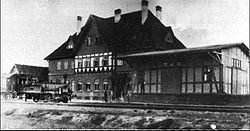Wegenstedt – Calvörde railway line
| Wegenstedt – Calvörde | |||||||||||||||||||||
|---|---|---|---|---|---|---|---|---|---|---|---|---|---|---|---|---|---|---|---|---|---|
|
Calvörde railway station 1908–1966
| |||||||||||||||||||||
| Course book range : | formerly 209c, 209k | ||||||||||||||||||||
| Route length: | 6.2 km | ||||||||||||||||||||
| Gauge : | 1435 mm ( standard gauge ) | ||||||||||||||||||||
|
|||||||||||||||||||||
The Wegenstedt – Calvörde railway line was a six-kilometer, single-track, non-electrified branch line that was shut down in 1967.
It was built from the free web-Wegenstedt Calvörde , a proper operation of the patch Calvörde in Saxony-indication .
Route
The route led from Wegenstedt on the Oebisfelde – Magdeburg railway through flat land to Calvörde, only six kilometers away. The Mittelland Canal was crossed.
Wegenstedt – Calvörde small railway
In the 19th century, Calvörde belonged to the Duchy of Braunschweig , but was an enclave in the Prussian province of Saxony . Efforts to connect the place with the construction of the Neuhaldensleben – Oebisfelde railway failed due to its membership in the Duchy of Braunschweig. So the route finally passed Calvörde around five kilometers west. After numerous, sometimes curious, new construction plans, a plan for a route from Wegenstedt to Calvörde was drawn up in 1906. On April 28, 1909, the concession to build and operate a small railway was granted to the municipality of Calvörde. In the absence of another operator, the municipality of Calvörde - with little financial support from the Duchy of Braunschweig - built the six-kilometer-long small railway on its own.
Freight traffic could already be started on September 22, 1909; Passenger traffic followed on October 1, 1909. Two two-axle steam locomotives were built in 1909 by the Borsig company in Berlin and shaped traffic on the line for three decades. These locomotives were added to the 98 series by the Deutsche Reichsbahn in 1949. The railway proved to be economically successful. Initially, four pairs of trains were driven as a freight train with passenger transport (GmP). There were also numerous beet trains during the harvest season . The travel time of the GmP was 13 minutes. Around 44,000 travelers were transported annually. After a decline during the First World War , the number of train journeys increased to six GmP train pairs in the second half of the 1920s. In 1928 38,000 people and 203,225 tons of goods are transported. In 1928 the construction of the Mittelland Canal began, which also increased freight traffic. A box girder bridge was built to cross the Mittelland Canal .
During the Second World War , the number of journeys even increased because the fuel for bus journeys was rationed. The track was even driven at night. After the GmP train journeys were discontinued in 1941/42, a double-decker railcar was acquired from the Gardelegen-Haldensleben-Weferlinger Kleinbahn (GHWK). This was returned to the GHWK in 1948. After a short break, two pairs of trains ran on the route again from May 1945.
On January 1, 1947, the small railroad was forcibly transferred to the Sächsische Provinzbahnen GmbH , but on August 15, 1948 it was absorbed by the United State-owned enterprises of Saxony's transport system . From April 1, 1949, the Deutsche Reichsbahn operated the line. From then on it belonged to the Reichsbahndirektion Magdeburg . The Deutsche Reichsbahn began using two class 89 steam locomotives from 1949 . The traffic on the route was still brisk. Charcoal, manure, stones, potatoes, cattle and canned goods were transported as goods. However, the superstructure deteriorated so that the travel time, which had been 13 minutes for decades, increased significantly. In the summer of 1964, the trains ran for at least 30 minutes, as half of the route could only be traveled at 10 km / h.
On September 24, 1966, passenger traffic was officially stopped. As early as May 23, 1966, buses had been running as a replacement rail service . Freight traffic ended on May 27, 1967. The route was dismantled immediately after the goods traffic stopped. Only the bridge over the Mittelland Canal remained standing until 1978.
The steam locomotives / railcars
the Wegenstedt-Calvörde Kleinbahn
| Track no. | design type | Manufacturer | Construction year | Factory no. | DR no. | text | |
|---|---|---|---|---|---|---|---|
| 1 | Bn2T | Borsig | 1909 | 7,234 | 98 6006 | Delivery on July 27, 1909 | z August 12, 1965; + January 17, 1966; ++ May 5, 1966 Raw Halle |
| 2 | Bn2T | Borsig | 1909 | 7,235 | 98 6007 | Delivery on September 2, 1909 | Sold on August 3, 1950 to VEB Glashütte Torgau |
| T1 | 1-Adm | NAG | 1927 | ??? | VT 133 511 | Rail bus | ++ December 19, 1957 |
traces
To the south of the Wegenstedt train station you can see the railway embankment that curves to the east. The Calvörde station building is a listed building and was a day care center until May 2007.
Others
The railway line was popularly known as the "stub" due to its short length.
literature
- Dirk Endisch: Small and private railways in the Ohrekreis . Verlag Dirk Endisch, Korntal-Münchingen 2007, ISBN 978-3-936893-12-0
Coordinates: 52 ° 23 ′ 21 ″ N , 11 ° 15 ′ 47 ″ E
